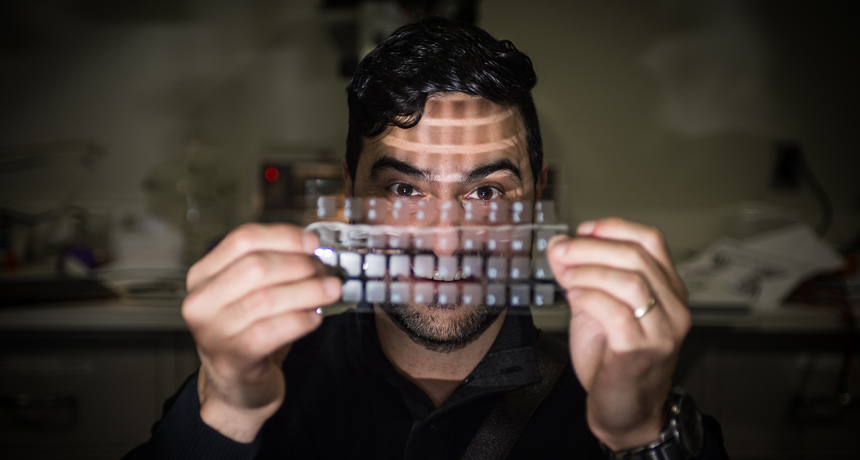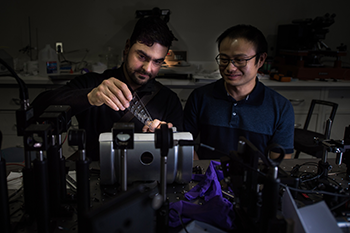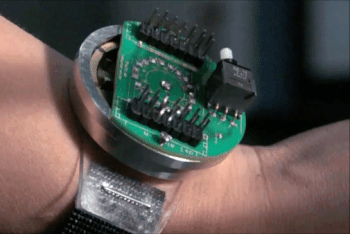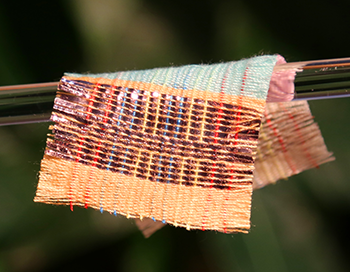What powers these electronics? We do!
New devices get their charge from everyday movements

Batteries not required. This foldable keyboard (shown with its inventor Nelson Sepúlveda) can harvest energy from keystrokes.
G.L. Kohuth/MSU
Inspiration often comes from unusual sources. Nelson Sepúlveda knows this firsthand. He got his big idea for a new source of power simply by looking out the window at the right time.
Sepúlveda is an engineer at Michigan State University in East Lansing. He studies materials that can be used to build tiny electronic devices. Those devices need power. But Sepúlveda doesn’t want to power them with batteries, which are bulky and wear out. He wanted to find something better.
In 2012, he realized one such power source was closer than he’d imagined. He had been discussing his research with a group of scientists. During the meeting, he looked out the window as a student ran by, wearing headphones. Her arms and legs swung back and forth. This jogger’s feet rose and struck the ground, up and down, again and again.
Suddenly it dawned on Sepúlveda: “There’s a lot of energy in that movement that’s not being used.”

He was looking at mechanical energy, the type associated with movement. It’s plentiful in every jogger — and every pedestrian. With that glance out the window, the engineer pictured a plentiful and renewable energy source. One day, he mused, that jogger’s movements could generate electricity to power the device connected to her headphones. But first, he realized, he’d need “to find ways to harvest this energy.”
Fast forward a few years. Sepúlveda’s vision is now much closer to reality.
In December 2016, his research team introduced a keyboard that generates an electric current as it is squished or expanded. It also can pull small bits of energy from the motion of each keystroke. If the material he used was adapted to be the screen on a smartphone, a swipe across it could help power the phone. A flexible computer screen, when folded up and placed in a shoe, could later charge as someone walks.
The possible uses for such technologies are limitless, muses Sepúlveda.
Last year, his group showed how a similar device could work as a portable, sheet-like speaker — one you might use to play music. But until it’s needed, the user could just fold it up and store it in a pocket.
Sepúlveda is one of many researchers building devices to turn everyday movements into abundant energy without making pollution. Nano means “tiny.” A generator is a machine that produces electric current. His nanogenerators aren’t really tiny. They just make electricity using tiny particles.

Researchers are inventing more and more creative ways to capture energy from our everyday motions. Some have created devices that can be installed in shoes, clothing and other items that people wear. Others have found ways to capture energy from motions such as falling rain, evaporating water or the rotating tires of a moving car. And on July 20, university researchers in Pennsylvania and Utah unveiled an energy harvester that can be worn like a watch. Walking or jogging while wearing it could generate enough power to run a small device. What type? It might power something to monitor someone’s health, according to Susan Trolier-McKinstry. She’s a co-developer and engineer at Pennsylvania State University in University Park.
Any movement is a potential source of energy, says Xing Fan. He is a mechanical engineer at Chongqing University in China. He helped develop a fabric that can capture some of this wasted energy. Special threads within it conduct electricity. Shirts made from such a material could generate power from the natural activity of whoever wears it.
“You move your body every day,” Fan says. So there’s no limit to the amount of mechanical energy available. The tricky part, he concedes, is figuring out how to get your devices to use it.
A recipe for electricity
Indeed, the challenge for researchers like Fan and Sepúlveda is figuring out how to translate — change — that energy into a form that devices recognize and can use.
The body stores and uses mechanical energy. Devices use a different form of energy: electricity. How do you transform one to the other?
You can find one answer to that question on a dry winter day. Walk around in a heavy sweater or shuffle across a wool carpet. Now touch a metal door knob. You’ll get shocked. Why? When the air is dry, particles called electrons build up on your body. (Wet air helps them escape into the room around you. Dry air doesn’t.) Electrons have a negative electric charge. When you touch the door knob, all those negative charges jump from your hand to the metal. You feel that jump as a surprising jolt. If the room is dark enough, you can see it as a tiny flash, too.

This effect is called static electricity. Many materials build up an electric charge when they’re rubbed against something else. Rub a balloon on your hair, for example, and it gathers enough electric charge to stick to a wall. Scientists use the word triboelectric (Try-boh-ee-LEK-trik) to describe materials that accumulate charge this way. It’s not a new idea. Ancient Greek scientists knew that they could build up energy by rubbing fur on amber, a kind of natural plastic produced by trees.
Energy builds up as atoms in the material absorb and release electrons. (In Greek, “electron” means “amber.”) Triboelectric materials trade and gather electrons as they jostle and bump up against each other. The movement of electrons creates electricity. And our electronic gadgets work only when they have a steady flow of electrons. Normally, that takes a power cord attached to some wall outlet or a battery. But those outlets aren’t portable, and batteries need to be replaced or recharged.
What’s more, devices are changing, notes Zhong Lin Wang. He is an electrical engineer at Georgia Institute of Technology in Atlanta. Many are shrinking in size. Some can even be implanted in the body to take measurements or keep someone healthy. Others can monitor the environment, agricultural crops or disaster zones. New flexible electronic devices include paper-like computer displays and electronic skin. For such uses, Wang says, maybe there’s a better way to provide power than plugging in a cord or inserting a battery.
Taking charge

Since 2005, Wang has been studying what he calls “self-power.” In 2006, he and his team introduced nanogenerators that use piezoelectric (Pee-AY-zo-ee-LEK-trik) wires. Such materials release a spark when they bend or are squeezed. When bent, the wires produced enough current to power small devices. But piezoelectric materials can be brittle, which means easy to break.
In 2012, Wang’s lab introduced a bendable generator that instead used triboelectric materials. You might think of it as a very small static-electricity factory. Wang called his invention TENG, for “TriboElectric NanoGenerator.”
It looks like a sandwich, with metal sheets serving as the “bread” and two triboelectric slices as the lunch meat inside. As the generator bends and flattens, its triboelectric materials rub together. This makes electrons build up on one side. Those electrons then pass through the metal to produce an electric current.
Wang built a floor mat out of the generator to demonstrate this. Simply stepping on the mat created enough electricity to power an alarm.
Since then, Wang has been fine-tuning his recipe. In 2015, he and Fan worked together to build a flexible TENG that looks like a piece of paper covered in ridges. And like a piece of paper, it’s flexible enough to be rolled. When it rolls or unrolls, it charges. It also can harvest energy from vibrations due to sound. With this feature, the TENG could be installed on a smartphone and collect energy from the sound of a user’s voice. That means people could charge their phones simply by talking on them.
In Michigan, Sepúlveda’s device has a similar basic design. But it works in a different way.

Imagine making a bed. “You take a bed sheet, lay it on the bed, and another sheet on top, and another on top of that,” says Sepúlveda. Those sheets, he says, will bend and curve. They touch each other in some spots and have air between them in others. Now, instead of fabric, imagine those sheets are made of flexible materials that can hold a charge. Next, place positive and negative charges inside each layer. As the layers compress and expand, charges get closer and farther apart. That generates a current.
The flexible materials that produce electricity in this way are foams, said to be ferroelectrets (Fair-oh-ee-LEK-trets). Sepúlveda described his device as a ferroelectret nanogenerator, or FENG. He and his students used it to develop that flexible, self-charging speaker. It can be folded up and tucked into a pocket for audio on the go.
Getting to a flexible future
These nanogenerators use cheap materials and produce a lot of energy for their size, says Wang. That makes them appealing. But challenges remain before any of these will work in the real world. For instance, triboelectric parts will wear down over time and stop producing as much electricity. Knowing this, scientists like Wang are looking for low-cost materials that will be durable and efficient. It will take long tests to make sure these generators won’t break down under normal use.
Once engineers have a winning formula, they will still have to get the generators and devices to share usable energy. And they need to figure out the best way to use the technology. Different devices and uses may have power demands that require a mix of smart approaches. That may mean, for example, combining different types of generators and materials to make hybrids.
Fan says the biggest challenge is to mine more energy out of everyday life, but without getting in the way. New gadgets are exciting, but they shouldn’t add extra weight or hassle to the user. “We want to do more, but we don’t want to carry more,” he says. And it’s important to find ways to generate energy without producing extra pollution.
He thinks that’s possible. So do the other researchers. They envision a future in which devices don’t “tax” their users with extra weight — and don’t tax the planet with extra pollution. In the drive to turn the body’s movements into energy, the ultimate goal of these researchers is the same. They want to find clean, creative ways to power our devices.
Indeed, says Sepúlveda, “Our main focus is to solve real problems, not only in science but also in society.”







